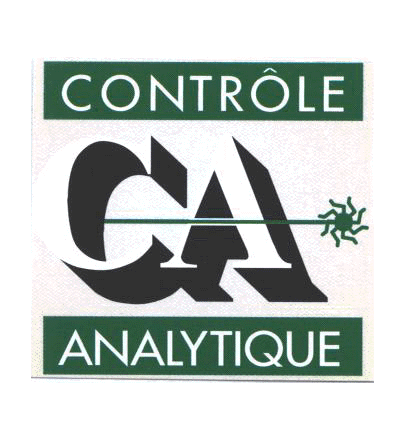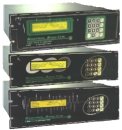After spending more than three years in research and
development, the first series of Controle Analytique trace
nitrogen in argon was born : the K2000. This unit, housed in a
large wall-mounted enclosure was first produced for steel
industry but soon found its place in the air separation
industry. The K2001 was released one year later. The K2001
series was designed specifically to meet the needs of industrial
gas cryogenic producers.
Less than ten years ago, the specification required for trace
nitrogen in argon, in many locations, was less than 10 ppm.
Today, this specification has dropped below the 1 ppm level with
the new technology for argon production and purification. The
K2001 is meeting this need perfectly with its lowest range of
0-1 ppm with 10 ppb resolution.
The K2001 gained wide acceptance in the industry but was soon
faced with a new challenge : the electronic industries had a
nitrogen in argon level below 10 ppb. Controle Analytique rose
to the challenge and, the K2002 was released this year. With its
first range of 0-100 ppb and a sensitivity of .1 ppb or .5 ppb
based on the mode in use, the K2002 is the first low cost ppb
nitrogen in argon available on the market. User-friendliness is
the philosophy behind the concept.
The K2002's main application is argon purifier monitoring. In
such purifiers (getter), the first impurities to break through
are nitrogen followed by methane. Consequently, by monitoring
the nitrogen, the end user has a clearer indication of the
purifier's status.
In special cases,the K2002 may be modified to monitor both
the methane and nitrogen as one impurity only. Different
arrangements are possible. The K2002, for example may execute a
reference reading (from another purifier in line with the sample
stream) and if the reading difference exceeds a user preset
limit, an alarm is generated. The K2002 comes in standard
configuration with the following :
An isolated serial port output is available as an option.
The helium background version of the K2001 and K2002 is
available. The K2001/2002 have other applications such as
specialized gas laboratories, heat treatment, and helium cooling
system for vacuum application, etc.
Our new products will be released shortly during Pittcon '98.
To mett customer demand, a new series of trace nitrogen
analyzers will be introduced : trace nitrogen in hydrogen, trace
nitrogen in oxygen (also used in any argon/oxygen background
mixture). These new units are specific to nitrogen.
In the Contole Analytique newsletter, we will keep you
informed of new product releases, application information, some
tutorials on plasma as well as useful tips. Your comments are
always welcome. Contact us via e-mail or phone.
Since the introduction of the K2201, we have seen major air
separation companies make it a standard for all their new
projects. Other companies made the move to replace their
existing analyzers (based on ion mobility, silent electric
discharge, or chromatography) with the K22001. A brief
description of key factors that set the K2001 apart from the
competition follows.
There have been mainly three different technologies used
since the sixties for online trace nitrogen analysis : ion
mobility, silent electric discharge, and thermal conductivity.
Thermal conductivity will not be covered below because of its
serious lack of sensitivity for this particular application (low
ppm level).
Ion Mobility
Ion mobility uses a radio active source (usually around 50
millicuries of tritium). The high-energy beta radiation ionizes
some of the gas passing through the cell. The difference in the
mobility of the ions of argon and nitrogen which are formed are
measured by an electrometer amplifier. The output is fed to an
analog readout or an analog-to-digital converter for display.
Ion mobility was more popular in the sixties and seventies
than it was in the eighties and less so today. The reason for
this his its lack of sensitivity below 2 or 3 ppm and linearity
limited to 100 ppm. The detector also reacts to C02,
CO, H2, and CH4, a serious drawback for
low-level measurement. It is also very sensitive to flow and
pressure variation into the cell. Finally, the paper work and
fees involved in the operation of a radio-active based device
(waste management) contribute to its decreasing popularity.
Silent Electric Disharge
There were at least three companies manufacturing this type
of analyzer for trace nitrogen in argon measurement. There is
some variation in their design but the basic concept is still
the same.
In the silent electric discharge or SED, the argon flows
through a cell made of pyrez with a quartz window. (Different
material may also be used). There are two electrodes connected
to a high voltage source on each side of this cell (generally a
7.5 KVAC, 60 Hz neon sign transformer). When the power is
applied, the argon/nitrogen mixture emits light. The nitrogen
emission is isolated with an interference filter and then,
transform to an electric signal generally with a
photo-multiplier tube.
There are three different types of signal conditionning for
this type of analyzer. One use a chopping wheel to modulate the
light beam. The signal measured by the photo detector is fed to
a tuned amplifier (or filter) whose frequency is the same has
the chopping wheel's. The filter's output is rectified and fed
to an analog meter or digital readout. The drawback with this
method is the noise ; the chopping frequency and pulse of light
from the cell are not synchronized. Also, a mechanical chopping
wheel always requires periodical maintenance.
Other manufacturers do not use the chopping wheel but they
use bandpass filter (tuned amplifier) to twice the frequency of
the cell's alternating power supply. We may also find a phase
sensitive amplifier, also called lock-in amplifier or sign bit
amplifier instead of a bandpass filter. Since the intensity of
the emitted signal is low and the signal itself is subject to
variations in the main frequency, the result for low-level
measurement will therefore range from passable to mediocre.
Also, the ionization process is not constant and ''Spikes''
signals are present. High flow is normally required (>2SCFH)
and over time, dirt deposits accumulate inside the cell from the
chemical reaction inside the cell (looks like brownish soot).
This result in a loss of sensitivity.
Some systems are also subject to what is called the ''phase
reversal'' phenomenon : when a high-level of nitrogen is
introduced into these instruments, the reading will decrease.
Consequently, contaminated argon may in fact be erronously
considered as a good product. What a nightmare for a plant
manager!
The K2001
The K2001 analyzer is based on a spectroscopic emission cell,
which is not a new technique in itself. It is in fact, the
frequency, intensity, regulation as well as the coupling
technique and focusing (stabilizing) electrodes used to keep the
plasma stable that are the main characteristics that make it so
sensitive, stable, and reliable.
The cell volume is less than 1 c.c. The power coupling to the
cell and the stabilizing electrodes help maintain plasma
position and minimize turbulence caused by gas velocity. All
this ensures a better penetration of the analyte (N2)
into the plasma zone. The reaction involved into the cell may be
described as follows :

This is the action of metastable argon on nitrogen molecules.
There is a strong emission of the second positive system of N2,
from the vibrationnal level V1=0. There is also a
charge transfer ionisation/excitation involved caused by the
transfer of charge between ions and atoms. Further information
on this subject, however, will be found in future editions of
the newsletter.
Special attention is paid to the optical system. Each optical
filter selected is tested with our spectrometer system before
being included in a K2001. We select a filter coating to achieve
optimum temperature stability and to avoid moisture-associated
problems. This filter is coupled with a lens that focuses the
beam of light so as to fix the center wavelength of the filter
properly.
The light is then directed to an enhanced photo diode. All
these components are mounted in a cartridge to maintain optical
path alignement.
The signal conditionning differs in many respects from the
competition. The K2001 amplifies the signal by direct-charge
transfer. The new K2001 series comes standard with an
analog-to-digital resolution of more than 1 part per million (20
bits) compared to the competition's 1 part per 4095 (12 bits).
There is no bulky photomultiplier tube (PMT) with high voltage
or a chopping wheel. Consequently, you do not have the problems
associated with such systems.
The entire system is controlled by a microprocessor. The
quality of both parts and assembly makes the K2001 a choice
instrument for the air separation industry. It is very popular,
for example, in truck-loading stations.
The following features set the K2001 apart from the
competition :
- User-friendly operator interface :
- Built-in diagnosis system ;
- Automatic calibration system available ;
- RS-232 or RS-485 communication port for data transmission
or modem
(a free communication software is include with theses
options).
- No maintenance required (nor consumable parts) ;
- Automatic flow regulation system ;
- Typical 10-second response time for rate of change over
90% ;
- Three measuring scales : 0-l, 0-10, 0-100 ppm (10 ppb
resolution) ;
- Exceptional stability (typical drift less than 1% over a
month) ;
- Automatic or manual scale change ;
- Low gas consumption (works with as little as 25 cc/min.) ;
- Particle filter ;
- Preconditioned stainless steel tubing ;
- Every analyzer includes software and data file
representing a 24-hour minimum duration performance and
drift test.
The K2001 is based on ''PLUG and PLAY'' philosophy. Our products
are characterized by their user friendliness. The qualified
Controle Analytique Technical Support Team will provide
assistance should you require application information, technical
support or service. Your call is important to us and as such, we
will follow up until customer satisfaction is achieved.
Consequently, please contact us should you need a trace nitrogen
measurement. We are certain that we can provide you with the
best solution for your application. We are so confident in our
analyzers performance that we will reimburse you if you are not
satisfied. We are proud to say that this situation never
happens.



